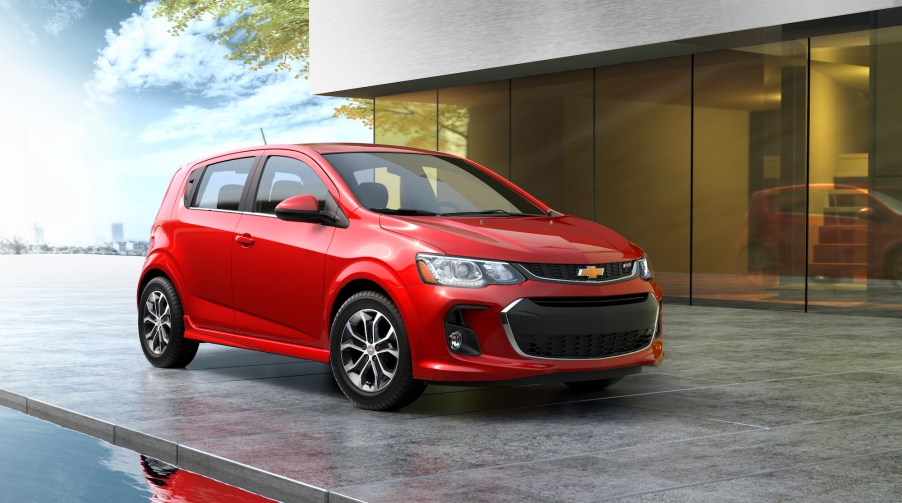
Does the 2020 Chevy Sonic Live Up to Its Speedy Name?
Historically, the Chevy Sonic sold in approximately 120 countries under various names, most notably the Aveo. Only in North America is it known as the Sonic. But as of 2020, Chevrolet ended production of this budget subcompact. Interestingly, five other automakers distributed the Aveo, including Suzuki, Ravon, Pontiac, Holden, and Daewoo (from 2002 to 2011).
More interesting yet, U.S. News considers the Chevy Sonic one of the fastest subcompacts under $20,000. It also offers fairly good standard safety features. And it comes as either a sedan or a sporty hatchback. Let’s see if the 2020 Sonic lives up to its speedy name.
The Chevy Sonic: An overview
In 2017, Chevrolet updated the Sonic’s exterior and added standard features, including a rear-view camera and touchscreen infotainment system with Apple CarPlay and Android Auto. A heated steering wheel and rear parking sensors became available that year as well. Subsequently, the automaker didn’t make any updates in 2018. In 2019, Chevy decided to make its turbocharged 4-cylinder engine standard across trims, ditching the naturally aspirated four-cylinder. For the 2020 model year, Chevrolet replaced the Sonic’s six-speed manual transmission for a six-speed automatic and updated its infotainment system.
The base 2020 Sonic LS comes standard with four-wheel anti-lock brakes, 10 airbags, one month of Chevrolet Connected Services, and one month of OnStar safety and security coverage. It retails for only $16,720. The Premier Sedan is the top trim, offering 17-inch painted-aluminum wheels, keyless open/start, an enhanced driver information center, and perforated-leatherette seating. This trim costs an additional $4,000.
According to one U.S. News review, a used 2017 Chevy Sonic LT or Premier is similar to a new 2020 model at a lower price.
The 2020 Chevy Sonic vs. the competition
The 2020 Sonic’s stiffest competition comes from another Chevy: the 2020 Spark. But the latter offers less power and interior space than the Sonic. Both of these subcompacts boast the same high-end standard features, and several options and packages place these vehicles among larger, higher-priced cars. When it’s all said and done, the 2020 Chevy Sonic offers practicality, while the 2020 Chevy Spark has a lower entry cost at $13,400. Choosing one over the other boils down to personal taste and budget. But soon, you won’t have much choice thanks to the Sonic’s retirement.
The next competitor is the 2020 Toyota Yaris, which is smaller than the Corolla. It comes with only the bare minimum in equipment and is less powerful than the Sonic. The good news is, less power means better fuel efficiency. On the flip side, the Chevy Sonic has plenty of tech features. Plus, it boasts a more powerful engine, handles better, and is sportier. The Yaris is a great city car, while the Sonic adds extra pep for more adventuresome drivers.
Last, there’s the 2020 Honda Fit, another discontinued subcompact. It’s available only as a hatchback but offers slightly more interior space than the Sonic thanks to Honda’s ingenious fold-flat rear-seat system. With the rear seats folded down, the back resembles the bed of a small pickup truck. With the seats up, the interior still provides passengers plenty of legroom. For drivers who don’t care about their passengers’ legs, the Chevy Sonic is faster and has an updated infotainment system.
The Sonic made a list of the fastest new cars under $20,000
The zippy 2020 Chevy Sonic is built to race through corners. Its handling will make you wish roads had more curves. Chevrolet sent the world a message: Smart designs don’t have to translate to hefty price tags, and even frugal buyers should enjoy driving these cars. That’s why the 2020 Sonic ranks on U.S. News’ “The 10 Fastest New Cars Under $20,000 for 2021.”
How many car manufacturers offer an economical subcompact with a 138-hp turbocharged four-cylinder standard? Because the Sonic is a front-wheel drive, you’ll be able to make the most of its horsepower. And considering its small size and minimal weight, you might find you’ve gotten a little ahead of yourself at red lights. Nonetheless, the thing about subcompacts is that excitement often quickly deflates once you attempt to outpace something with more horsepower.
Take U.S. News’ advice and choose wisely when considering the base suspension versus the sport suspension. Sport-tuned suspensions are great for cornering around tracks, but their added weight puts a dent in top speed. Additionally, sports suspensions provide a rougher ride than the base suspension. So unless you’re a weekend track warrior, keep it simple so you can enjoy the 2020 Chevy Sonic’s pep in the city.


